Dashboard Design: Fundamental Overview
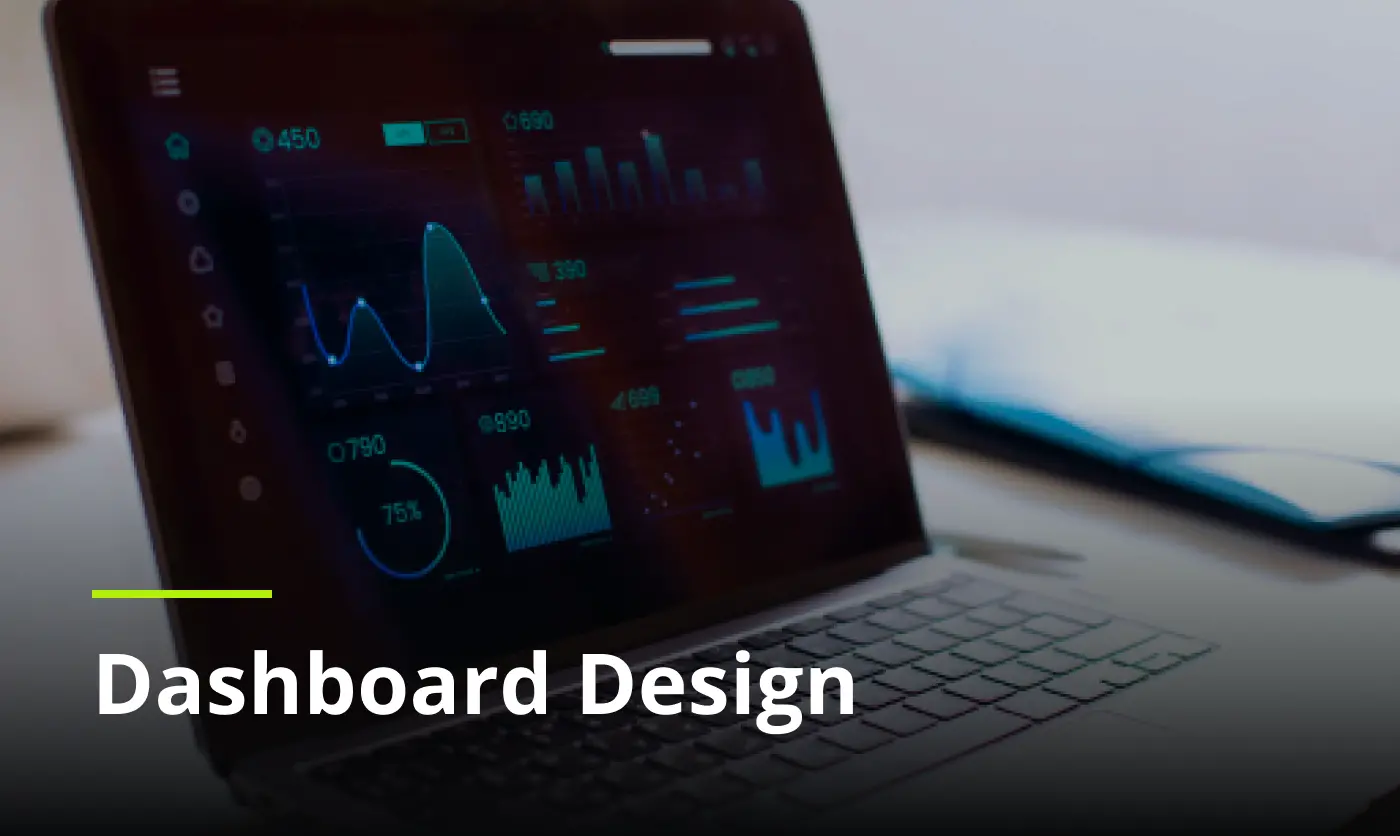
Dashboard design is one of the most essential points when it comes to the data visualization process. To produce a successful panel, it is necessary to follow the fundamental principles of UI/UX so our experts have created this article to highlight the useful data that plays a crucial role in the performance of the project.
We will cover the dashboard design best practices, what this term means, how to design one in a 5-step guide, and more. The layout for consoles is one of the most effective ways to display data and related information and in our summary, you can get acquainted with the details and expand your knowledge.
Learning about designing dashboards and having a full understanding of the principles behind data visualization is becoming incredibly important nowadays, as choosing the right methodology is critical to your progress toward your goal, and our review will shed some light on these issues.
What is dashboard design?
While we are stepping into the subject of designing dashboards we can’t leave behind the term meaning — to talk in a nutshell it has become a trending topic to discuss in different outlines in recent years. However, many businesses are still not aware of the usage and how it can be implemented. For this reason, we are offering this theoretical article starting with the definition.
The best dashboard design is created for a visual display of data consolidated within a single monitor. By visually representing essential information, you make it easier to understand and allocate your time and money resources.
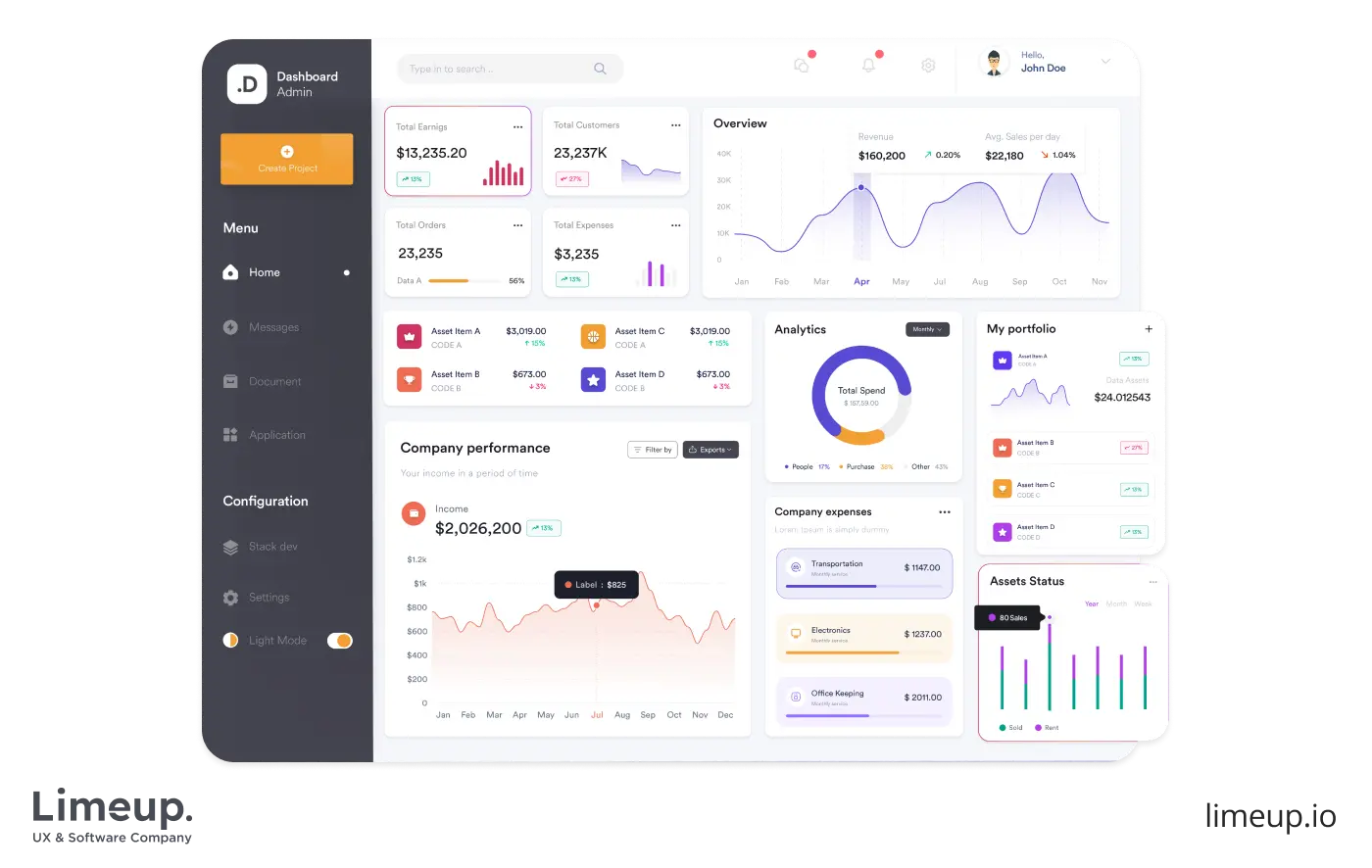
As for readability and intuitive perception, consoles have to be represented with a single glance. Since they are highly customizable, you are able to control their content to make it within an array of techniques — bar graphs, tables, color coding, widgets and gadgets, annotations and callouts.
Following the advice of your UX consultant, keep in mind that the leading advantage of panels is to represent the visual part of data within various graphic elements. You are transforming raw information into actionable insights, making complex things easier and more accessible. Effective instrument boards simplify the data analysis process.
Subsequently, the flexibility of good dashboard design has the ability to draw and serve the main purpose — to make critical business decisions based on a data-driven approach.
There are also a number of possible variants of control panels — according to your business needs and purpose, for example, marketing, operational, performance, strategic, HR and others. Each of them focuses on a particular topic catering to users’ needs. Let’s take a closer look at the main ones that can be offered by UX Design Agencies in London or other regions.
Types of dashboards
In general, there are four categories with different purposes, and therefore, with disparate indicators that will be measured in the process. To understand the specifics of dashboard designing services in more detail, let’s dive into the review of the main types. This will help make the choice easier when it comes time to decide on the type of services.
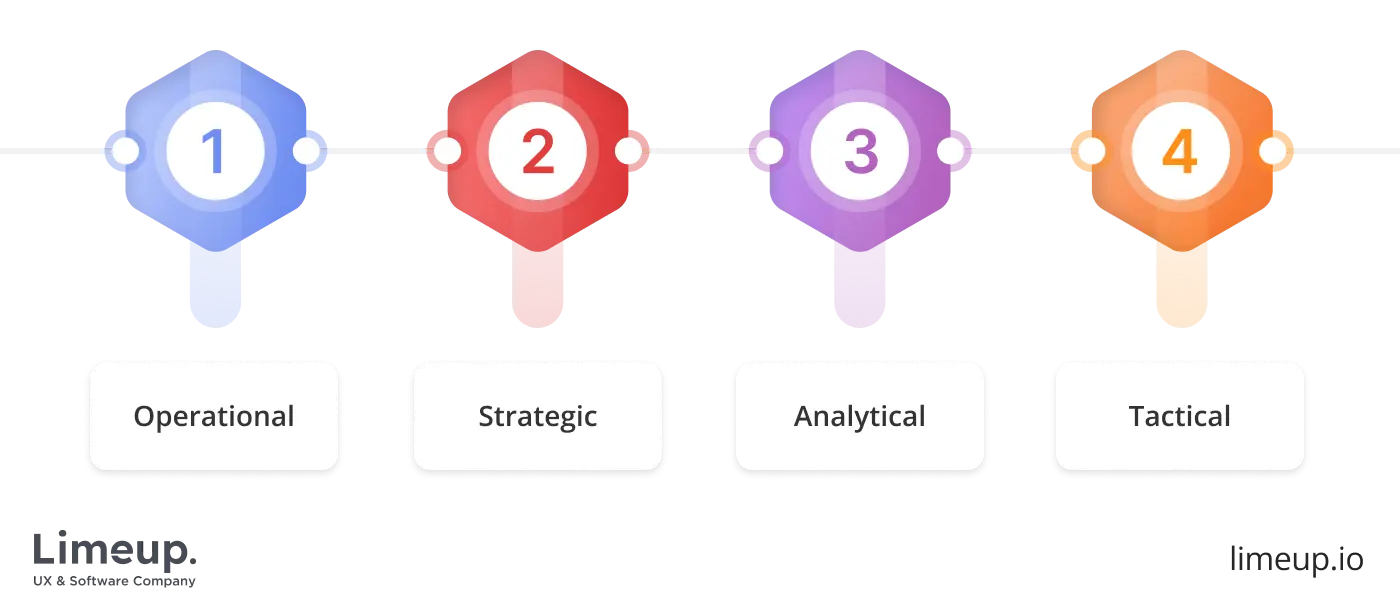
-
Operational. They represent a general overview of business goals, but are used to track activity in a specific area and inform the owner about what is happening at a particular moment. You can analyze input data and results in parts, detail key metrics in real time, which allows you to take the needed measures immediately when necessary.
Case study: if you are a company manager and want to monitor the implementation of a project step by step, then such a keyboard will allow you to see all stages from time control and budget management to sales team income and invoicing.
-
Strategic. Required for any business owner or senior manager. This is a kind of bird’s eye view to quickly assess the overall state of the company. As a rule, they offer high-level performance metrics (competitor results, historical data, and set control levels). In these cases designing dashboard consoles are also suitable for forecasting performance in a certain period.
Case study: imagine that your goal is to triple revenue and halve customer churn. Then your reporting would include actual and target revenue for the month, goal achievement, and comparison with the previous year.
-
Analytical. Use data visualization to delve into history and identify and predict trends. The main difference is the level of analysis and the data set with a large number of filters, views, visualization types, which is reflected in the design.
Case study: if you have a SaaS application for a call center, you will need the ability to interpret the number of sales calls, agent productivity, average call duration, as well as traffic without involving outsourced specialists.
-
Tactical. It is not a simple dashboard design for deeper analysis with specific interpretation of processes and provision of detailed reports on projects and goals. Typically used to process a large array of data, examining specific points with filtering and segmentation. The result is the discovery of patterns and opportunities for advancement.
Case study: an expert in one of the fields decides to analyze his direction in terms of efficiency and growth prospects and chooses a tactical panel, which allows him to plan long-term goals.
Based on the format of your business and its focus, it is worth choosing one of these varieties. To operate intentionally, a composition has to be tailored and meet the requirements of end-users — answer their questions, serving as a tool to track how well the company meets objectives and business goals.
The importance of dashboard UI & UX design
Most overviews say that a simplified way of data visualization and performance is essential for every business — you can make critical decisions and assessments. Since you are able to present a large quantity of data, thereby you are able to represent better results within your product or service operation.
There are a multitude of reasons why implementing instrument boards is a perfect concept for gaining momentum and providing a holistic view of your company’s operations. We will consider the most unobvious ones about dashboard design ideas that can’t be tracked by the untrained eye:
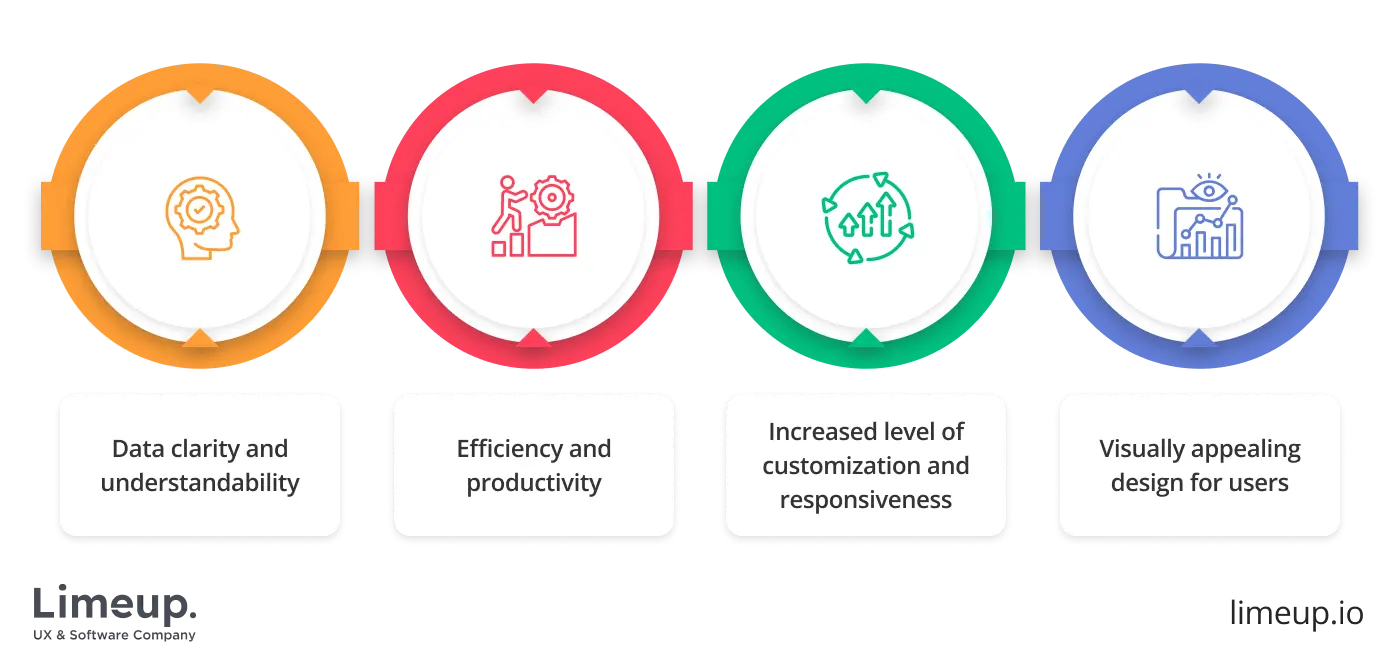
-
Data clarity and understandability. Ensure that the interface is intuitive and clear, so that users are able to quickly grasp the layout, navigate through different visualizations, and easily interpret the presented data without any confusion.
Therefore you can’t ignore accessibility — designing an interface you have to consider novice users and provide sophisticated tools for advanced users. We mean tooltips, documentation, customizable features, etc.
- Efficiency and productivity. Using dashes for UI and UX design you can improve the named options by streamlining workflows, optimizing cognitive load and allowing users to focus on representative data. Further, your workers will be able to make more informed decisions instead of wrestling with the interface and user experience.
-
Increased level of customization and responsiveness. Since every person has its own requirements for website dashboard design, you are able to present them with such a solution — including drag-and-drop functionality, adjusting the visual part, etc.
Moreover, the responsive UX design of your instrument proves seamless adaption of different devices — users can reach the control panel using tablets, PCs, or smartphones.
-
Visually appealing design for users. Paramount features are essential, still, don’t forget that users have to easily perceive your data to drive insights. Therefore you can capture users’ attention and maintain their interests in the control panel through the use of various tools.
For example, in dashboard UX design you can use icons, typography, and innumerable data visualization techniques — tables, graphs, or else to present not a bland panel but visually appealing UI and interactive user experience.
In summary, in terms of UI and UX it’s essential to create user-friendly interfaces that are simultaneously attractive and efficient. You have to prioritize clarity, accessibility, and a high level of customization so that you will reach the highest tier of user satisfaction and drive positive outcomes for your service or product.
Key principles of effective dashboards design
Experience shows that people respond faster to images than to text, which means that a successful interface layout can largely determine the user experience, which in the long term affects the success of a website or application.
Although dashboard design key principles are not something immutable, there are still certain principles that allow you to extract the maximum benefit from data. These are the brief ones we want to tell you about.
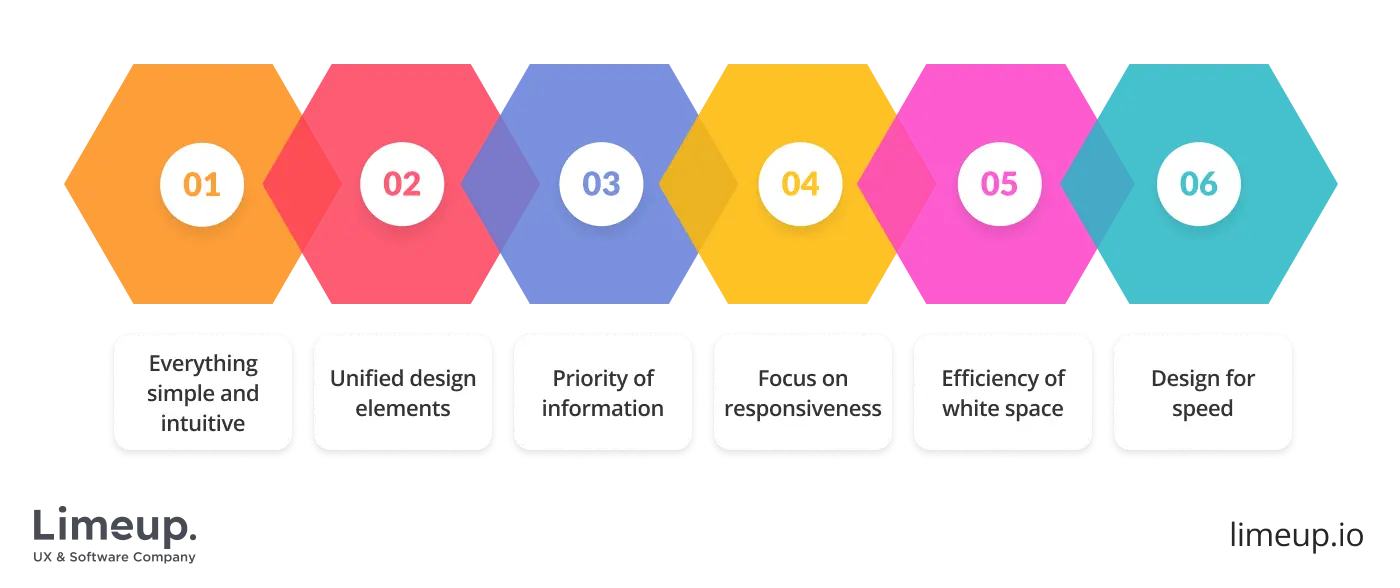
- Make everything simple and intuitive. It is much more useful for apperception and using if the panel is simple, with a minimalist design. This allows you to quickly and easily access the necessary information. Otherwise, clutter can be disappointing and make you refuse to use the product at all. Clear and concise language in combination with logical navigation will be the key to success.
- Unified design elements. To consistently create a visually appealing image, try to use the same fonts, colors, and icons on all parts. This approach creates a sense of unity and recognition, and also contributes to easy understanding and navigation through the panel.
- Priority of information. Making the most vital data easy to access and prominently displayed helps you make informed decisions. Visual cues, logical data organization, and KPI cards at the top direct the user straight to the important points.
- Focus on responsiveness. This is now a key element of dashboard design UI , as the rise of mobile devices forces us to adapt to different screens and resolutions. This is facilitated by a flexible grid system, media queries, and avoidance of small details.
- Efficiency of white space. Proper distribution of these areas can draw attention to important information, separate sections, and create a sense of visual flow.
- Design for speed. Loading time is not the last argument for a positive user experience. Statistics say that almost 53% of users leave a website if it does not load within 3 seconds. Lightweight images, the ability to compress files, and optimize code minimize waiting time.
We have covered the key principles, but it is also important to remember the consistency of the layout of elements, regular updates, and maintaining the accuracy of data and sources. And then your panels will be invariably popular with users.
How to design a dashboard?
Since you expect standardized creation, here we are going to inspect the development process of a console within basic steps. However, not every business owner is familiar with what is involved in the nuances of building.
We will explain it in understandable terms below so that you can realize what to expect from these steps and how to develop a control panel that meets your expectations and business needs using key dashboard design principles. For now, let’s jump right into the stages.
| Step | Tasks | Implementation paths | |
| 1. | Know your audience | Identify what data users need and analyze future possible platform content. | Try to create an average portrait of your potential client and think about what you would like to view and learn from the control desk data. |
| Recommendations: Do not lose the sense of developing an effective design, because the main task is to make an effective tool for obtaining data in the decision-making process, which is based on specific ideas. Remember that the data should not be complex and should be well visualized. | |||
| 2. | Define goals | Identify the needs and expectations of the target audience, defining what data will need to be collected and presented in UX dashboard design, and therefore – what tools will be needed for this. | Defines the functionality of each element, such as a drop-down menu or filters, to get a complete solution in the form of a ready-made toolbar optimized for all users. |
| Recommendations: The selection of specific elements should be based on the goals of the end user. Contextualization of data requires the provision of meaningful information and explanations that help users interpret additional data. | |||
| 3. | Choose metrics and KPIs | Key indicators should be reliable, measurable and tied to business goals. Allows you to avoid information overload and provide only the necessary high-quality data. | Choose based on the format and objectives of the business and customize any package – it can be conversion, revenue, number of leads, etc. |
| Recommendations: to understand what makes a good dashboard, choose those indicators that help track performance and analyze business efforts without including third-party parameters that distract and weigh down the product. | |||
| 4. | Visualize data | Serves to effectively present the information received in accordance with the set priorities. They are used to demonstrate the relationship between variables. | Use different methods: bar charts, line graphs, pie charts, heat maps, etc. |
| Recommendations: use both static and dynamic visualizations to design for dashboard, as well as different methods of data manipulation. Implement different formats of working ranges, ranking of lists of elements, infographics. | |||
| 5. | Optimize for responsiveness | Adapt the functionality and visual content for use on different devices, and ensure accessibility. | Test the console for usability on different devices, evaluate speed, display quality, and responsiveness. Use alternative text, access to keyboard shortcuts, and compatibility with screen readers. |
| Recommendations: do not forget to iteratively improve the user experience design and identify opportunities for improvement. Metrics based on changing requirements will help you with this. | |||
To create the perfect panel use the basic principles we have described above and always keep in mind the needs and objectives set at the beginning of the creation process.
Dashboard design best practices
You may be wondering what can improve the development process since it’s an extremely crucial point in business operations and discovering in-depth insights about how your product or service is performing on the market.
By conducting rigorous research you are able to unveil the best practices and look at UX design trends so here are the leading things to pay attention to when designing an instrument board.
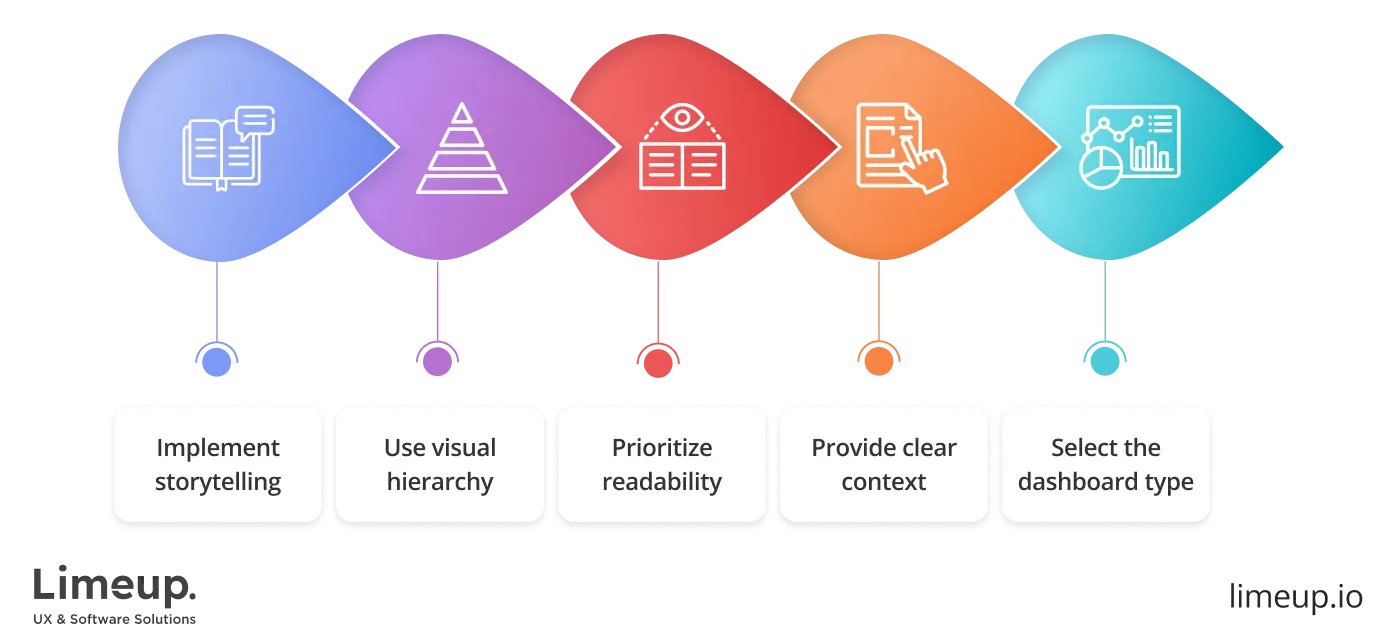
- Implement storytelling
This point refers to KPIs and metrics choosing and therefore you have to tell a story using the data — thereby you effectively represent data using visualization for performance indicators. Storytelling is a powerful tool for conveying complex data into a visually appealing console using real-time data.
Since forward-thinking businesses have to represent their data effectively, storytelling in dashboards design is essential. You have to build a bridge between the presented information and how it will be perceived by end-users, and storytelling is your robust tool.
- Use visual hierarchy
Since you have to guide end-users’ attention it’s essential to establish a clear visual hierarchy. Ensure to arrange visual and text elements — titles, headings, logical order of visual parts, what content is represented.
One of the easiest ways to highlight essential data or elements is to use font size in dashboard UI design. Another point stands for choosing colors wisely — strategic implementation to highlight key data, keep it from overwhelming and detracting from readability.
- Prioritize readability
Ensure that the process is conducted according to clear and legible fonts — right font sizes, the visual part is not overcrowded with visual elements and annotations are available and easy to read.
When choosing fonts for dashboard UX design remember to represent your specific style of data, consider your tone of voice, what type of infographic you will be using in constructing the keyboard. Don’t be afraid to experiment with fonts and sizes, your goal is to make the text the most visible and readable.
You can even use comic fonts, it’s essential for them to not be the same so that you can style your text and simultaneously not be very different since it will confuse your end-users. Find web-friendly fonts and, based on our experience, it would be perfect to implement two or three different fonts that are interchangeable.
- Provide clear context
Whether you are preparing elements for full-fledged data visualization, it’s cool but worth nothing without clear context and insights. Help users to interpret visualized data by adding relevant content, highlighting essential parts of statistics, and you can also enable interactivity.
Implement not only the visual part of your UI dashboard design but also incorporate filters for statistics, dropdown menus, and various functionalities that allow users to operate your data. Thereby you help users to interpret the provided information filtering out irrelevant data, uncovering deep insights about your solution, etc.
Remember that you are representing a visual display of complex data — consolidate and arrange it within a one or a few screens considering clear context so that users can receive maximum out of your console.
- Select the dashboard type according to your needs
Since there is no one-all-fit answer for a type in designing dashboards that will be perfect for your business, you have to consider your business needs and expectations. Each of them is focused on platform-specific analytics, so the receiving user has to be ensured that the information is created according to their needs.
When properly implemented a dash can be used for receiving in-depth information about a product or service so ensure that the type reflects what is needed — shorter or longer timeframes, vast or simplified amounts of data etc.
We have outlined only the most essential UX dashboard examples but remember that it’s an intuitive process powered by checked methods of performing. You can implement one, two, or all practices if it’s needed — the more is better since each of them aims to improve your invention.
Summing up
UX dashboard is a user-oriented way to present essential data that covers your business objectives and needs. Using this method you are able to come down to diligent development of control desks and understanding users’ true desires — clear context, in-depth understanding and insights, etc.
In our detailed guide, we have tapped into what stands for the right work-line, the steps you need to take when creating one and what are the best practices according to your unique business needs.
If you would like to receive a consultation about dashboards design, ensure to contact Limeup and we will schedule a complimentary meeting to discuss your expectations. We are experts in crafting user- and web-friendly utilities that help you to reach your full potential.

